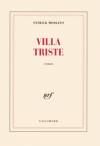Auteurs contemporains
Discours critique sur les œuvres de littérature contemporaine
Outils pour utilisateurs
Outils du site
Villa Triste
Patrick Modiano - Paris, Gallimard (Coll. Blanche), 1975, 192 p.

« Un été des années soixante. Une petite ville française au bord d’un lac, près de la Suisse. Victor Chmara a dix-huit ans et se cache parce qu’il a peur. D’étranges personnages hantent cette ville d’eau, comme ce docteur que l’on surnomme La Reine Astrid… Mais il y a surtout Yvonne, avec son dogue allemand… Une recherche du temps perdu. » (Quatrième de couverture)
Documentation critique
BLANCKEMAN, Bruno, « Patrick Modiano: L’Occupation en abyme de la fiction », dans Marc DAMBRE, Richard J. GOLSAN et Christopher D. LLOYD, Mémoires occupées: Fictions françaises et Seconde Guerre mondiale, Paris, Sorbonne Nouvelle, 2013, p. 55-61. +++ Chapitre de collectif
TRITSMANS, Bruno, « Les Secrets de la bibliothèque dans Villa triste de Patrick Modiano », dans Norman BUFORD et Marja WAREHIME (dir.), The Documentary Impulse in French Literature, Amsterdam, Rodopi, 2001, p. 113-124. +++ Chapitre de collectif
BLUM-REID, Sylvie Eve, « Writing nostalgia: Fiction and photography », thèse de doctorat, Department of French, University of Iowa, 1990, 275 f. +++ Thèse de doctorat / mémoire de maîtrise
### « This study examines a number of articulations between memory, nostalgia and photography in contemporary French fiction. While it is generally assumed that pictures serve a descriptive function, the status of images in texts is still vague. This dissertation describes the relationship between nostalgia and the images inscribed in the novels and essays of Marguerite Duras, Patrick Modiano and Georges Perec. I trace the way their writing appropriates photographic properties and manipulates the apparatus, its mechanisms and its visual products. The primary texts include Duras’s L’Amant (1984), Modiano’s Rue des Boutiques obscures (1978), Livret de famille (1977) and Villa triste (1975), and Perec’s Les Choses (1965), Un Homme qui dort (1967) and W ou le Souvenir d’enfance (1975). While these writers are connected with filmmaking practices, I restrict my study to an analysis of the photographic image in texts, except for Perec’s film Recits d’Ellis Island (1979). All of these works are contextualized in the 1970’s–an epoch whose dominant nostalgic contours are deeply imbedded in the history of mentalities. My analysis stems from a philosophical tradition of questioning guided by Roland Barthes, Walter Benjamin, Susan Sontag and Vladimir Jankelevitch, but it also acknowledges the importance of psychoanalysis. Ultimately the purpose of the project is to offer a more challenging reading of these writers in the light of what we call “photographic writing”–an approach not solely confined to these three authors. In a final part, we confront their texts with several photographers’ practices and suggest that there is a potential exchange in the treatment of both photographic texts and photography itself. The juxtaposition of words and images within narratives locates this inquiry in the realm of postmodernism as it is the privileged site of reflections on visual representations, memory and nostalgia. » (résumé joint à la thèse)
La version PDF de la thèse est disponible pour les membres de communautés universitaires qui ont un abonnement institutionnel auprès de UMI - Proquest. ###
RABATÉ, Dominique, « Revisitant Villa triste », dans Roger-Yves ROCHE (dir.), Lectures de Modiano, Nantes, Éditions Cécile Defaut, 2009, p. 221-241. +++ Chapitre de collectif
JULIEN, Anne-Yvonne, « Du statut du souvenir heureux dans les romans de Modiano. Villa triste (1975), Remise de peine (1988), Fleurs de ruine (1991) », dans Anne-Yvonne JULIEN (dir.), Modiano ou Les intermittences de la mémoire, Paris, Hermann (Collection Savoir Lettres), 2010, p. 219-238. +++ Chapitre de collectif
| Villa Triste (oeuvre) | |
|---|---|
| Titre | Villa Triste |
| Auteur | Patrick Modiano |
| Parution | 1975 |
| Afficher | oui |